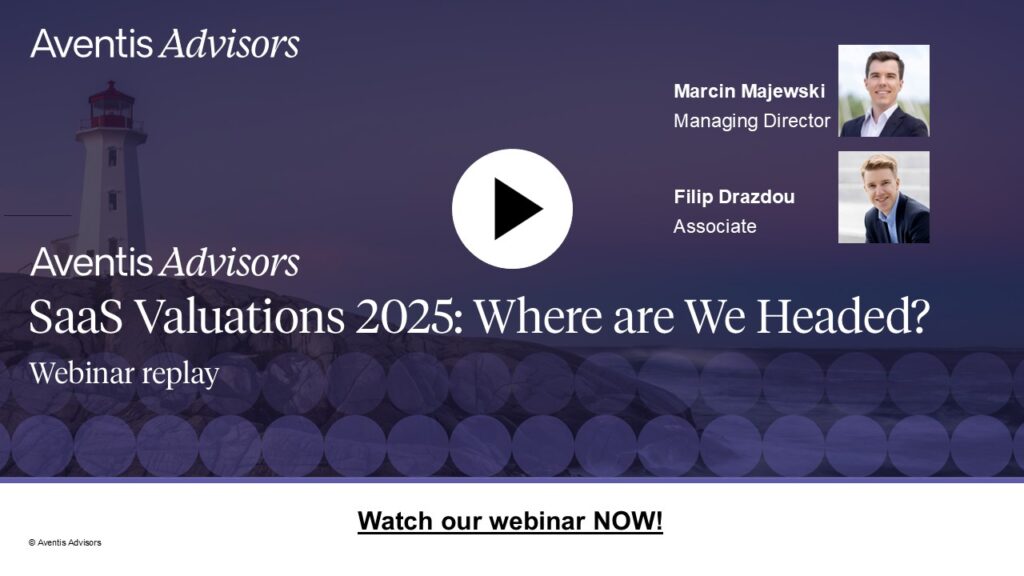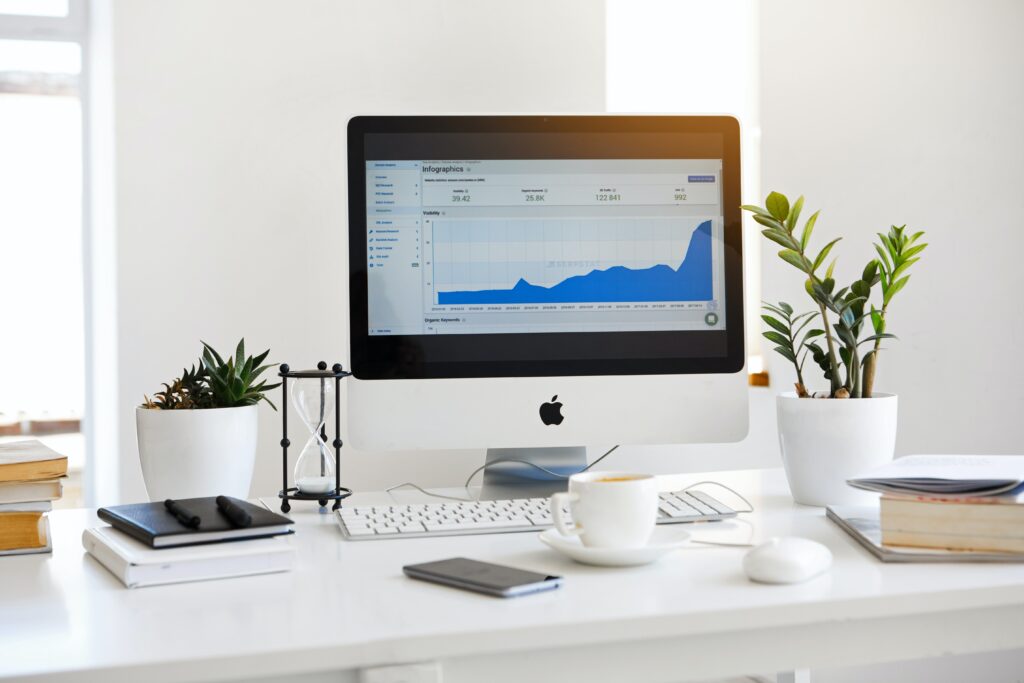Understanding how to value a SaaS company is critical for founders preparing to raise capital or explore a potential exit. Valuations are based on recurring revenue metrics (ARR, MRR) together with profitability and growth indicators. These metrics highlight the predictability and scalability of your business model. By focusing on them and understanding how investors interpret them, you can better position your SaaS company for stronger outcomes in fundraising or M&A.
Key Takeaways
- Recurring revenue is the foundation of valuation. SaaS companies are typically valued using ARR multiples, which highlight predictable subscription-based income rather than one-off sales.
- Growth and retention determine premium multiples. A smaller SaaS company with robust growth and high net revenue retention (NRR) can often command a higher valuation multiple than a larger but slower-growing competitor.
- Profitability and efficiency matter more in today’s market. Investors pay close attention to EBITDA margins, CAC payback periods, and burn multiples to judge whether the target’s growth is sustainable.
- Market positioning and strategy influence investor perception. A large TAM, strong competitive differentiation, and proprietary technology can add a valuation premium.
Understanding the SaaS Business Model
SaaS companies operate in a unique space within the tech industry. They host applications on web-based platforms, making services remotely accessible to customers. The novel structure of these companies lies in their subscription-based model. Unlike traditional software licensing models, which demand a one-time payment for perpetual use of locally installed software, SaaS customers pay a periodic fee, usually monthly, quarterly, or annually.
This subscription model generates a specific type of revenue, termed recurring revenue. It includes maintenance, customer support, and the right to use the software. Billing terms such as pricing amount, fixed vs. tiered fees, and frequency of billing drive this recurring revenue.
The SaaS industry, with its myriad subscription models, boasts diversity. From freemium to fixed fee, tiered fixed fee, pay-per-seat, pay-as-you-go, hybrid, and custom models, the SaaS industry is teeming with different ways to bill customers. Each model has its own unique impact on the consistency and predictability of revenue.
The ARR Bridge: Breaking Down Growth
While ARR and MRR define the size of a SaaS business, investors also want to understand how revenue evolves over time. This is typically illustrated through an ARR bridge, which decomposes revenue changes into clear drivers.
The example above begins with $5.0 million of starting ARR. Over the period, the company adds $1.5 million from new customers, representing revenue from clients that were not previously part of the customer base. In addition, existing clients increase their usage and upgrade contracts, contributing $0.7 million of expansion ARR.
Revenue declines appear in two categories. Existing customers who continue to use the product but downgrade or reduce their spending account for $0.2 million of downgrades, while complete cancellations represent $0.5 million of churn.
After accounting for these positive and negative movements, the company ends the period with $6.5 million in ARR.
This bridge makes the dynamics of growth more transparent. It shows that the business is acquiring new customers and expanding existing accounts at a pace that outweighs downgrades and churn. For investors, this pattern signals strong revenue quality. This pattern supports higher valuation multiples compared to a company that grows primarily through new customers but struggles to retain or expand existing ones.
Core Valuation Metrics
SaaS companies are most often valued on EV/Revenue multiples, with ARR as the anchor metric. Unlike one-off or transactional revenues, recurring subscription income gives investors predictability and visibility into future performance. This predictability is why ARR has become the standard for valuing SaaS companies. Ultimately, the multiple you achieve depends on three key factors: growth, revenue retention, and profitability/efficiency.
If you want to dive deeper into where SaaS valuations are headed in 2025, we’ve prepared a webinar replay that breaks down the latest market dynamics, multiples, and investor priorities.
EV/Revenue as the Benchmark
The enterprise value to revenue ratio (EV/Revenue) compares a company’s total enterprise value to its ARR. It is the most widely used measure in SaaS valuations, especially for businesses that are not yet profitable. While EBITDA and cash flow multiples remain relevant for mature SaaS businesses, revenue-based multiples dominate in earlier stages, where recurring revenue is the most reliable performance measure.
ARR vs. MRR in Valuation
ARR and MRR play a role in valuation, but they serve different purposes:
- MRR (Monthly Recurring Revenue): Provides a short-term view of subscription income, helping investors monitor near-term momentum and detect early changes in growth or churn
- ARR (Annual Recurring Revenue): Offers a comprehensive, annualized perspective and is the preferred benchmark for applying valuation multiples
Investors usually anchor valuations on ARR but review MRR trends to understand short-term dynamics.
Growth Metrics that Matter
Growth is one of the most powerful drivers of SaaS valuation multiples. Investors pay premiums for companies that scale revenue quickly while staying efficient. As a rule of thumb, SaaS businesses growing annual recurring revenue by more than 30 to 40 percent each year are generally considered strong performers. However, growth on its own does not guarantee a premium valuation. The quality of that growth, reflected in customer retention and expansion, is just as important.
A central measure of revenue quality is Net Revenue Retention (NRR), which shows how much recurring revenue existing customers retain and expand over time:
- Below 100%: Signals revenue leakage, even if new clients are added.
- 110–120%: Considered healthy and sustainable performance.
- 130%+: Viewed as best in class and highly attractive to investors.
Even small improvements in retention can significantly shift valuation. For example, reducing churn by just one or two percentage points can increase a company’s value by double digits.
Another widely used benchmark is the Rule of 40, which combines growth and profitability in one measure. A business that achieves a combined score above 40 percent demonstrates both expansion and financial discipline, and such companies are typically rewarded with higher valuation multiples.
Profitability and Efficiency
While many SaaS companies are not profitable in early stages, investors still evaluate efficiency. Mature SaaS businesses with ARR above $5 million are typically valued on EBITDA multiples. Smaller or founder-led companies are often assessed using Seller Discretionary Earnings (SDE). This measure accounts for owner compensation and one-time expenses, making it a more suitable benchmark for early-stage or closely held businesses.
Two additional efficiency measures often influence valuations:
- CAC Payback: The time required to recover customer acquisition costs. A payback period shorter than 18 months is generally seen as efficient.
- Burn Multiple: Measures how much cash is spent to generate each dollar of new ARR. A burn multiple below 2.0 signals disciplined growth.
Tracking these metrics early helps signal to investors that your growth is not only fast but also sustainable. Companies that combine strong ARR growth, high NRR, and efficient capital use often command significantly higher valuation multiples than peers of similar size.
Decoding SaaS Valuation Multiples
As discussed above, revenue multiples are the dominant valuation method for SaaS businesses, especially those not yet profitable. These multiples simplify aspects of a discounted cash flow model by highlighting potential future cash flows and associated risks. However, they have also proven volatile, moving with growth, retention quality, and broader market sentiment.
Comparing Public and Private SaaS Valuation Multiples
Public SaaS companies are typically valued using EV/Revenue multiples, while private transactions often apply EBITDA multiples less consistently. Public valuation multiples have been volatile: reaching an all-time high of 16.9x in August 2021, declining to 6.2x in November 2022, and recovering slightly to around 7.2x. These swings reflect macroeconomic conditions such as the digitization surge during COVID and subsequent corrections.
By contrast, SaaS valuations in M&A transactions have shown greater stability. For founders, this means you should avoid benchmarking directly against the lofty multiples of public SaaS businesses without adjusting for growth, size, liquidity, and control differences.
Impact of Market Trends on Valuation Multiples
SaaS company valuation multiples can be significantly swayed by market trends. For instance, the SaaS market size has seen remarkable growth, escalating from $113.82 billion in 2020 to an estimated $716.52 billion by 2028. This growth directly impacts saas business valuation, making it an essential factor to consider.
Investor priorities are shifting, too. They’re now placing greater emphasis on the path to profitability for SaaS companies, moving away from the previous norm of prioritizing growth-at-all-costs due to increasing capital costs.
Valuation multiples for SaaS companies have shown sensitivity to changes in their growth rates, particularly in periods of low interest rates, with the sectoral median growth rate standing at 22%.
Comparative analysis of market performance shows that while the median public SaaS valuation increased by 18.5% year-to-date, the Nasdaq saw a greater rise of 36.7%.
Evaluating Customer Metrics
Customer metrics are central to SaaS valuations. Churn rate, or the percentage of customers who cancel within a given period, is one of the most closely monitored figures. Lower churn rates indicate loyal customers and predictable revenue streams, making a company more attractive to investors. Even a one or two percent improvement in churn can lift valuations by double digits.
Customer lifetime value (CLTV) is another critical measure. It represents the total revenue a customer is expected to generate over their relationship with the company, calculated using MRR, average revenue per account (ARPA), gross margin, and churn rate.
Strategic Factors Influencing SaaS Company Value
The valuation of a SaaS company is influenced by a number of strategic factors. The total addressable market (TAM) is a vital metric for assessing a company’s potential scale and market penetration, influencing valuation as investors look at both current and future opportunities.
The competitive position of a SaaS company significantly shapes buyer perspectives on the company’s future growth prospects, contributing to the perceived value and potential for market expansion.
Finally, a company’s intellectual property, such as proprietary technology and data assets, can provide unique competitive advantages that can be monetized, significantly enhancing the value of a SaaS company.
Financial Performance Analysis
Understanding key financial metrics is essential for assessing the financial health and stability of a SaaS business. SaaS gross margin, calculated using the formula: Gross margin = [(Revenue – COGS) / Revenue] x 100, is one such metric.
Analyzing revenue data by customer allows SaaS companies to demonstrate the predictability of their revenue, which is critical for investor assessments. For instance, public SaaS companies have a median and mean GP Ratio of 8%, indicating cash burn, which affects valuation multiples.
Detailed and current accounting records are crucial to effectively evaluate a SaaS business. Monthly granularity in the Profit & Loss statement helps in capturing trends that are particularly important for early-stage, fast-growing SaaS companies, including operating expenses.
The Art of Pricing Strategy in SaaS Valuation
The valuation of a company can be significantly affected by its pricing strategy. SaaS companies can adopt various pricing strategies, including the SaaS+ model with both recurring and transactional fees, to build a predictable revenue stream and explore additional earning potential.
To improve market valuation, SaaS businesses should focus on a pricing strategy that enhances their value proposition and maintains competitive pricing. This strategy balances the need to attract customers with the need to maintain sustainable profit margins.
Pricing flexibility through strategies such as tiered pricing and responding to market changes can bolster revenue models. Considered annual price adjustments can amplify company valuation.
Management and Organizational Strength Assessment
A company’s valuation can be significantly swayed by the strength of its management team and organizational structure. A strong management team with SaaS industry experience is instrumental in navigating market challenges and fostering growth.
Investors value companies where the management team can operate effectively without the owner’s constant presence, signaling a robust organizational structure.
Effectively documenting and transferring knowledge within the management team is crucial during exit processes to ensure continuity and minimize dependency on key individuals.
Preparing for a Valuation: Steps to Maximize Your SaaS Company’s Worth
Founders can take several steps to maximize valuation.. For instance, having a large and growing Total Addressable Market (TAM) is appealing to investors and can lead to a higher valuation of a SaaS company by showcasing significant revenue opportunities.
Diversifying customer acquisition channels illustrates a company’s ability to monetize in various ways and reduce dependency on a single source, thus potentially increasing the company’s market value and optimizing customer acquisition cost.
Efficient and well-documented operational processes within a SaaS organization can significantly contribute to a favorable valuation by ensuring business continuity and success.
Practical Tips for Founders and Investors
Understanding which metrics drive SaaS valuations at different stages is essential for both credibility with investors and long-term strategy. Founders should actively optimize conversion rates, strengthen customer retention, and scale efficiently to build a durable growth profile. It is not enough to show top-line ARR expansion; demonstrating how growth is achieved and sustained is what differentiates high-quality companies in the eyes of investors.
Beyond financial indicators, investors also assess external factors such as competitive intensity, technical dependencies, acquisition channels, and market saturation. These shape scalability and reveal how resilient the business may be under different market conditions. Founders who present a clear go-to-market strategy, transparent unit economics, and evidence of defensible differentiation give investors greater confidence in future performance.
Ultimately, founders who master these fundamentals and communicate them effectively are better positioned to negotiate favorable terms, attract the right investors or buyers, and secure premium valuations. Proactively tracking, improving, and presenting these metrics not only strengthens fundraising and M&A discussions but also lays the foundation for long-term enterprise value creation.
Summary
In conclusion, understanding and mastering SaaS valuations is a multifaceted process. It requires a deep understanding of the SaaS business model, core valuation principles, customer metrics, strategic factors, financial performance analysis, pricing strategies, organizational strength, and much more. With this knowledge in hand, both founders and investors can make informed decisions and navigate the valuation landscape with confidence.
Why you need a SaaS M&A advisor
Each SaaS business is unique, much like every founder’s journey. Therefore, it’s essential to consult with experts in the SaaS M&A landscape, particularly advisors who specialize in the sector and can understand your unique circumstances.
SaaS M&A advisors understand how to navigate market dynamics, valuations, and coordinate all the necessary workstreams. While you concentrate on running your business, SaaS M&A advisors work diligently to ensure that no detail is overlooked and advocate for the best possible deal. Their success is directly linked to yours through a success fee structure, and their influence on the final sale price can therefore be substantial.
About Aventis Advisors
Aventis Advisors is an M&A advisor for SaaS companies. We believe the world would be better off with fewer (but better quality) M&A deals done at the right moment for the company and its owners. Our goal is to provide honest, insight-driven advice, clearly laying out all the options for our clients – including the one to keep the status quo.
Get in touch with us to discuss how much your business could be worth and how the process looks.





